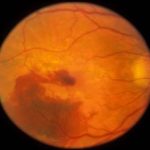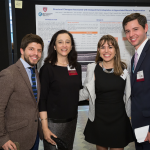At the 2022 Sense-ation! Gala, macular degeneration researchers in Mass Eye and Ear’s Ophthalmology Department along with patient Laura Brennan brought awareness to a disease that claims people’s vision: AMD. Watch this video to learn more about this research and how it has impacted patients like Laura, and what work remains to better treat this disease.
Mass Eye and Ear’s chief of the Department of Ophthalmology, Joan W. Miller, MD, has dedicated her career to finding ways to treat and slow the progression of age-related macular degeneration (AMD).
Over the last two decades, Dr. Miller and her colleagues at Mass Eye and Ear/Harvard Medical School have pioneered the development of photodynamic therapy using verteporfin (Visudyne®), the first approved pharmacological treatment able to reduce and slow vision loss in patients with AMD. Her team was also heavily involved in research breakthroughs that led to a new class of ophthalmic anti-vasculear endothelial growth factor (VEGF) drugs, which have revolutionized care for millions of patients with AMD and eye other sight-threatening retinal diseases.
Dr. Miller and fellow Mass Eye and Ear AMD research colleagues Demetrios Vavvas, MD, PhD, Director of the Retina Service, and Deeba Husain, MD, a member of the retina service and co-director of the AMD Center of Excellence at Harvard Ophthalmology, however point out that more work needs to be done. That’s why they continue to devote research efforts towards several projects looking to improve care for patients with AMD.
“The ultimate goal is to have treatments for early AMD and be able to prevent any vision loss from it,” said Dr. Miller. “In order to do this, we need to treat AMD at its earliest stages. But to develop these treatments, we need to understand more about the biology of AMD.”
Finding new treatment targets for leading cause of vision loss
AMD causes people to experience blurry vision or blindness in the center of their visual field. About 11 million people in the U.S. alone have the condition, and more than 150 million worldwide are affected. There are two forms of the disease: dry (the most common form) and wet AMD.
In people with dry AMD, light-sensing cells called photoreceptors in the eye die off, resulting in vision loss. This is particularly of interest to Dr. Vavvas, whose team’s main goal is to figure out why the photoreceptors are dying and what can be done to slow and eventually stop that process.
“The main root of our research is to develop therapies that are applicable to as many people as possible in as soon a time as possible,” said Dr. Vavvas.
Dr. Vavvas has partnered with Dr. Husain to look for ways to better personalize care for patients, whose AMD cases may differ from one person to the next.
“AMD is challenging because it is a very complex disease because it not only stems from a person’s genetic makeup, but external factors like diet, lifestyle, and environmental factors,” added Dr. Husain.
One way Mass Eye and Ear researchers have tried to better understand these complexities is by using artificial intelligence (AI) to analyze patients’ retinal images in order to uncover new clues about the disease and when vision loss starts to occur. They are doing this using one of the largest databases of its kind under the leadership of John B. Miller, MD, director of Retinal Imaging at Mass Eye and Ear.
Another key research advance is in metabolomics, which is the study of small molecules called metabolites which are key to identifying AMD in its earliest stages. According to Dr. Husain, metabolites are used in many conditions as an early biological marker (biomarker) for disease.
A bright future for patients with AMD
The goal one day is that these research projects can turn into better detection methods that can be used to determine if AMD is present at the earliest point possible. From there, a drug can be prescribed to prevent any serious forms of the disease and to prevent severe vision loss.
The researchers believe the future looks promising to deliver better therapies to patients thanks to these ongoing research efforts, and patients like Laura Brennan could not be happier more attention is being paid to this blinding condition.
“This disease is affecting the baby boomer. We’re a really big bunch and I think we shouldn’t be forgotten,” she said. “It’s affecting my friends, people I know and love, and we need some help.”



Hi I’m interesting to learn more about prevention after macular hole surgery. Is there anything to prevent happening again?
Thanks
I have AMD both eyes wet. The injections in my right eye are not helping anymore snd vision is very blurred. Dr Yoon operated on my right eye twice to keep it open from right facial paralysis
Now eye waters a lot. Dr Richmon also operated on me to fix my esophagus. I am really interested in your research for AMD. Thanks for doing this. Am grateful for the information
I am very grateful for Eye and Ear My life was saved there in 2015-2016
I live in St.Paul, MN, and have been provided heath coverage for 40+ years by Health Partners, an HMO. I was diagnosed with dry AMD several years ago and it advanced to wet AMD in 2022 when I began receiving injections in both eyes. Later in 2022 and continuing I’ve been treated with the newer Tier 5 drugs, but unfortunately not until I had already suffered damage to my left eye. I recently discovered another retina secialist with M Health Fairview here at the University of Minnesota who was a resident and then on fellowships there with you. I’ve heard that AMD is likely genetic and I’m learning that more of my family apparently had or are now being diagnosed with it. So I have made an apppointment to consult with this retina specialist and have her review my treatment reord and retinas scans up to this point. When I saw that she had been a resident there and also received fellowships for further training and researach I decided to check your website. Very interested in following research and evaluation of effectiveness of newer treatments.